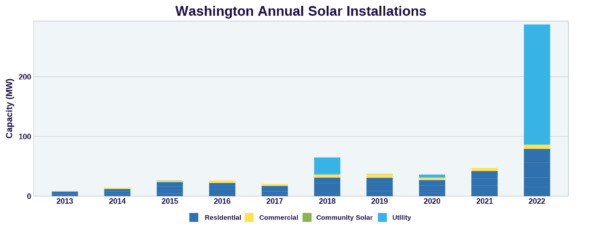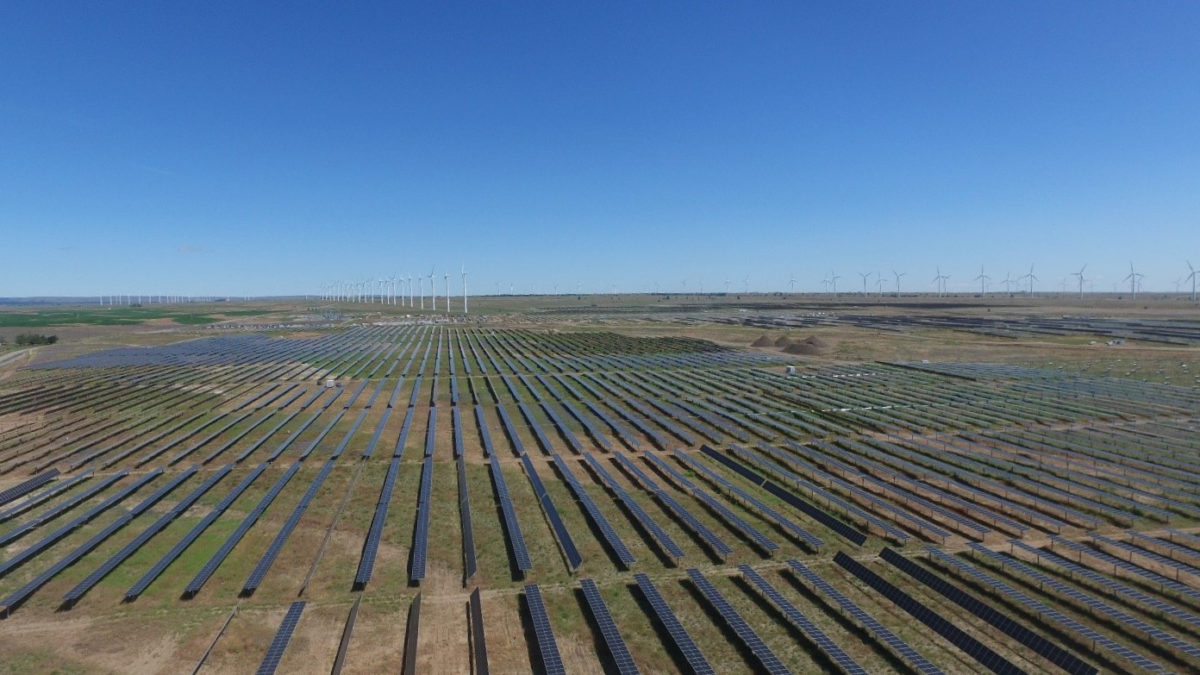Washington, home to Seattle and plenty of rainy days, is proving that solar can be cost-effective even in cloudy conditions. While it had lagged other states with similar sized economies in the past, in 2022 Washington ranked 15 among the states in terms of solar capacity, nearly doubling its cumulative installed capacity to 585 MW.
This equates to enough solar to power just under 60,000 households, said the Solar Energy Industries Association (SEIA). SEIA estimates that $1.3 billion has been invested in solar in the state, with nearly 150 companies and 4,000 employees working in the industry.

SEIA projects that another 1.4 GW of solar will be added over the next five years, more than doubling cumulative installed capacity once again.
Incentives
Solar customers who install systems of 100 kW of capacity or below are eligible for net metering in Washington. The policy was enacted in 1998 and remains available today from the three main utilities operating in the state. Net metering involves a solar customer sending excess daytime energy production to the grid in exchange for credits on their utility bills.
The Washington Utilities and Transportation Commission website contains links to net metering specifics for the three major utilities Avista Corporation, Pacific Power & Light, and Puget Sound Energy.
Washington residents also have vested rights to solar easement laws. This means that neighbors cannot build structures that shade an existing solar array. Furthermore, Washington’s solar rights laws prohibit homeowners’ associations from blocking residential solar projects.
Thanks to the Inflation Reduction Act of 2022, Washington residents and all U.S. residents alike are offered the Federal Investment Tax Credit (ITC). The credit applies to 30% of the installed system cost and can be rolled over if you do not have a large enough tax appetite in year one.
Based on a 4.9 kW system, informational site SolarReviews estimates the price of a Washington solar array to be an average of $11,647 after receiving the federal ITC. This equates to $2.77 per Watt.
In April 2022, Washington passed a solar incentive program aimed at expanding the opportunities for low-income residents to access renewable energy through an increased focus on installing community solar projects in the state. HB 1814 created a new $100 million incentive program, which began in 2023, that will provide funding for low-income households and low-income service providers’ installing solar.
Like the state’s previous solar incentive programs, Washington State University (WSU) Energy Extension will manage the $100 million in funding, providing grants to community solar projects around the state.
Notable project
This February, Avangrid announced the completion of construction and activation of a 150 MW solar project in Klickitat County, making it the largest solar facility in Washington by a large margin. Lund Hill solar sits on roughly 1,800 acres of mixed-use land leased from private owners and the Washington Department of Natural Resources, the state’s solar power land lease.
The project supplies electricity as part of utility Puget Sound Energy’s (PSE) program called Green Direct, which enables governments and large commercial customers to purchase 100% renewable energy contracts from dedicated local sites.
Governor Jay Inslee celebrated the activation, commenting, “with our efforts this upcoming session, this should be the first of many clean energy projects that bring good-paying jobs and affordable, zero-emission energy to Washingtonians.”
The project will supply electricity for PSE’s second round of the Green Direct program. So far, the program has connected more than 40 customers with renewable energy, including six state government agencies, like the Washington Department of Health, Ecology, and Transportation. PSE targets 100% clean energy by 2045, as mandated in Washington’s Clean Energy Transformation Act.
Up next
Last time, the pv magazine USA tour of state solar incentives reviewed New Mexico, and next, we will head to Oregon.
This content is protected by copyright and may not be reused. If you want to cooperate with us and would like to reuse some of our content, please contact: editors@pv-magazine.com.









By submitting this form you agree to pv magazine using your data for the purposes of publishing your comment.
Your personal data will only be disclosed or otherwise transmitted to third parties for the purposes of spam filtering or if this is necessary for technical maintenance of the website. Any other transfer to third parties will not take place unless this is justified on the basis of applicable data protection regulations or if pv magazine is legally obliged to do so.
You may revoke this consent at any time with effect for the future, in which case your personal data will be deleted immediately. Otherwise, your data will be deleted if pv magazine has processed your request or the purpose of data storage is fulfilled.
Further information on data privacy can be found in our Data Protection Policy.